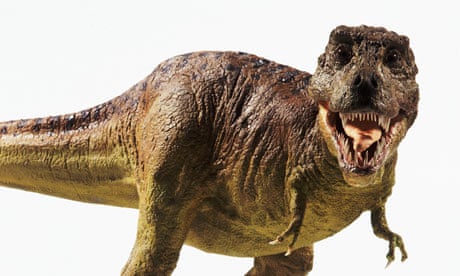The Tyrannosaurus family, of which the most famous species is T. rex, were among the last dinosaurs to appear on the planet, around 80m years ago. These large carnivorous theropods were only on the planet for a relatively short time, but they had a huge impact on our understanding of dinosaurs - partly because more specimens exist from these final stages than any earlier time in history.
T. rex, which lived around 67-65m years ago, was named in 1905 by the American palaeontologist Henry Fairfield Osborn. Its early discovery and North American heritage may explain its position as the world's most famous dinosaur. Bones from around 30 individuals, including several near-complete skeletons, have been found throughout western North America and in no other part of the world. It is reckoned to have weighed up to 6 tonnes and been up to 13 metres long, including a powerful tail that served to make this bipedal dinosaur very stable.
Living up to 28 years, full-grown adults are reckoned to have been able to run at speeds of up to 25mph (any faster could have been lethal if they fell over). It is believed that small ornithischians of the Cretaceous period (notably ornithopods and ornithomimids) could run much faster, but it is interesting that T. rex and its relatives possessed similar hindlimbs to these smaller speed merchants, suggesting that juvenile tyrannosaurids, not limited by body size, were faster runners than their adult relatives.
Depictions of T. rex commonly imply it had weak, spindly forelimbs, but in fact they would still have been 10cm or so longer than a typical adult male's arms - and more powerful, too, with two long, strong fingers (with large claws) at the end of each limb. The fact it could not reach its mouth with its hands implies these forelimbs were used mainly for grappling with prey rather than for feeding.
The design of a T. rex skull is also notable for the size of its olfactory lobes relative to the size of its brain, suggesting it may have had a strong sense of smell to use when hunting.
Also, it possessed one of the largest eye sockets ever seen, so probably had good vision, too - particularly as the skull shape implies that its eyes pointed further forward than most other dinosaurs, which would have given T. rex more binocular (3D) vision. This characteristic was also true of some smaller theropods such as Velociraptor, but not of any other large dinosaurs.
There is little evidence of how T. rex hunted. The postulation that it might have been a scavenger rather than a predator carries little firm evidence; the discovery of fossilised T. rex dung - lumpy and made up of bone fragments - suggests it could crush the bones of other dinosaurs with its robust teeth. The fact that none of its close relatives, the tyrannosaurids, lived near to T. rex may explain its size, as it is thought to have faced no competition from related predators.
T. rex was first discovered in Wyoming in 1900 by Barnum Brown. Originally named Dynamosaurus imperiosus, the specimen is now in the Natural History Museum and one lower jaw is on display.
Did you know?
Standing at four metres high at the hips and 13 metres long from head to tail, the largest, most complete and best preserved T. rex skeleton yet discovered resides at The Field Museum, Chicago - and its name is Sue! Unveiled in 2000, Sue's fossilised bones are now a permanent feature at the US museum. Despite the name, experts don't actually know whether Sue, who was found at the Hell Creek Formation in South Dakota, is male or female.
